Molecular Spectroscopy Market Size
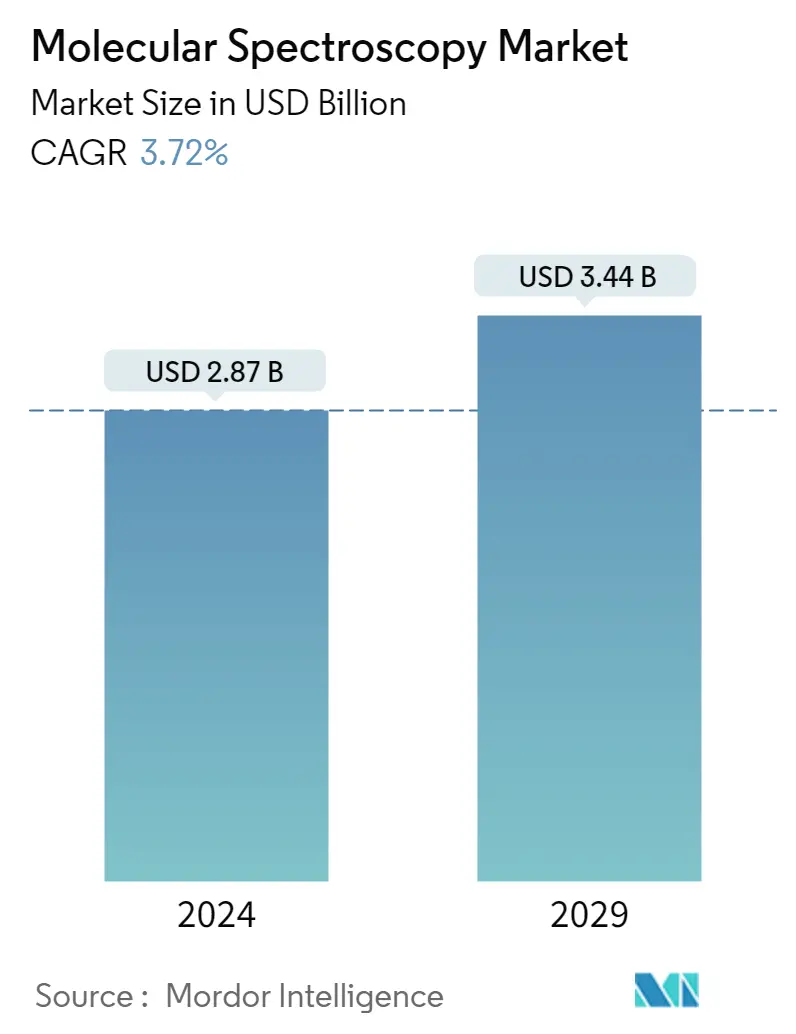
| Study Period | 2019 - 2029 |
| Market Size (2024) | USD 2.87 Billion |
| Market Size (2029) | USD 3.44 Billion |
| CAGR (2024 - 2029) | 3.72 % |
| Fastest Growing Market | Asia Pacific |
| Largest Market | North America |
Major Players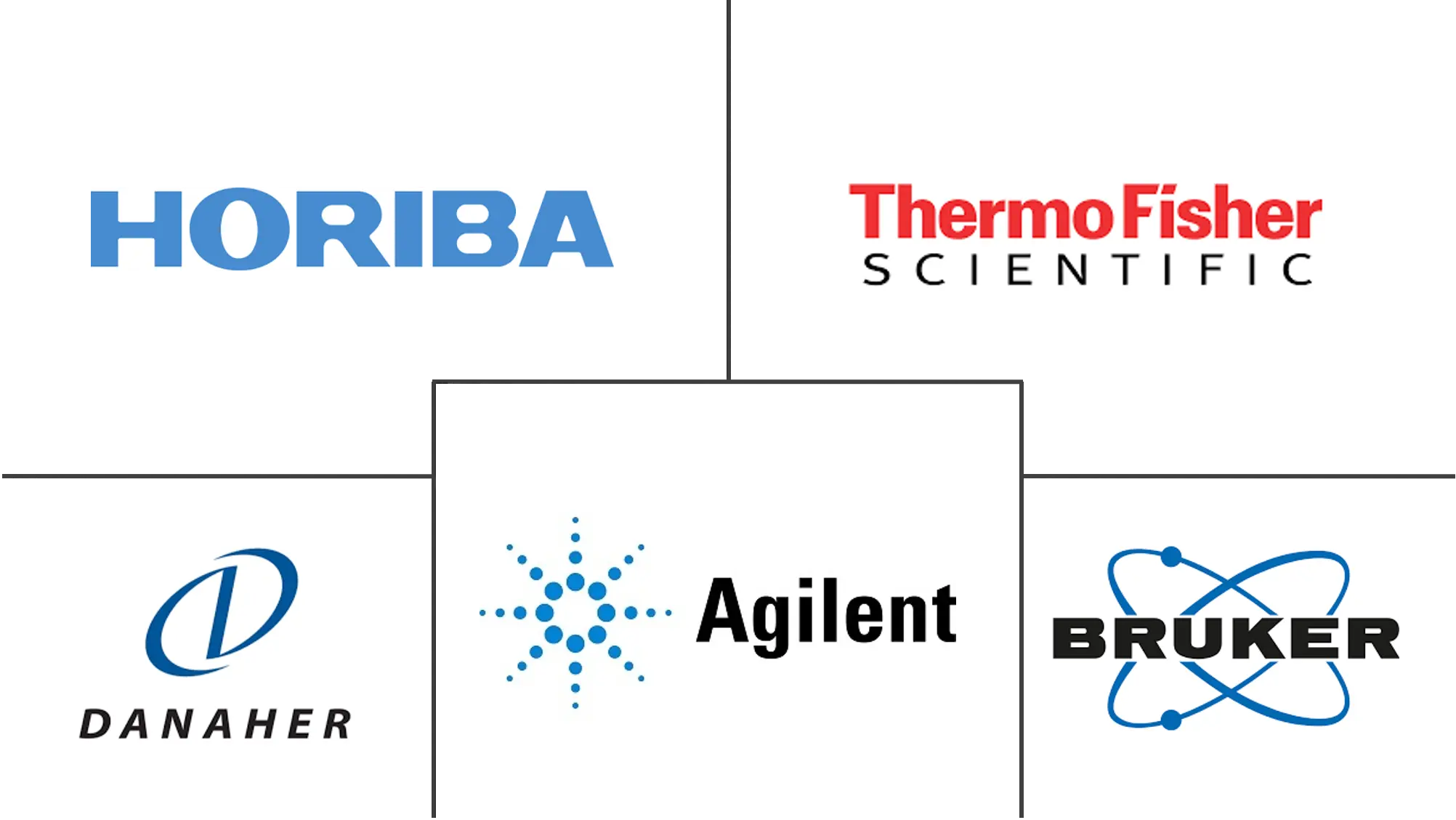
*Disclaimer: Major Players sorted in no particular order |
Need a report that reflects how COVID-19 has impacted this market and its growth?
Molecular Spectroscopy Market Analysis
The Molecular Spectroscopy Market size is estimated at USD 2.87 billion in 2024, and is expected to reach USD 3.44 billion by 2029, growing at a CAGR of 3.72% during the forecast period (2024-2029).
The major factors driving the market include the rapid adoption in the pharmaceutical industry, penetration of MS technology in various verticals, and increased emphasis on the discovery of newer molecules by pharmaceuticals.
The growing COVID-19 pandemic has also had a positive impact on the market as scientists are increasing the applications of Raman spectroscopy for COVID-19 testing. For instance, a Northern Arizona University (NAU) research team was found developing a new test technology for SARS-CoV-2 using single-molecule surface-enhanced Raman spectroscopy (SM-SERS). The project was named 'Development of a New Test for SARS-CoV-2 Using Single-Molecule Surface-Enhanced Raman spectroscopy' and was awarded a USD 200,000 grant from the National Science Foundation's Rapid Response Research (RAPID) funding program. Therefore, with the increase in research and development activities by pharmaceuticals related to drug discovery, the demand for molecular spectroscopy is consistently expected to rise over the forecast period.
Molecular spectroscopy is being used in the research and development (R&D) of pharmaceuticals and other biotechnology products, and one of the molecular spectroscopy types used in R&D is near-infrared spectroscopy (NIR). In recent years, NIR spectroscopy has also gained a wide appreciation within the pharmaceutical industry due to its major advantages over other analytical techniques that include easy sample preparation and the expectation of chemical and physical sample parameters from one single spectrum. Therefore, the rising affinity toward this technology has been widely noted, which may drive the growth of the market.
Molecular spectroscopy is also found to be widely adopted across different application sectors, including pharmaceuticals and many others. Raman spectroscopy has proven to be a strong analytical technique for drug discovery and pharmaceutical development.
It is being used to study the structural activity relationships and optimize the reaction conditions and other parameters, such as polymorph and formulation screening, which lead to the scaling up required for the transfer of drug compounds from discovery to development. Hence, the market is expected to grow rapidly during the forecast period.
Molecular Spectroscopy Market Trends
This section covers the major market trends shaping the Molecular Spectroscopy Market according to our research experts:
The NMR Spectroscopy Segment is Expected to Observe Good Growth Over the Forecast Period
Nuclear magnetic resonance (NMR) spectroscopy is an analytical chemistry technique used in quality control and research to determine the content and purity of a sample and its molecular structure. The advantages of NMR spectroscopy are that it requires less sample preparation and a non-destructive method, retaining the molecules being examined.
With the rise in COVID-19 cases, there is an increasing demand for research and development activities from pharmaceutical companies, which has stimulated the demand for drug discovery and development.
In recent years, NMR spectroscopy has become the leading technique for determining the structure of organic compounds, and it has wide usage in application areas, like pharmaceuticals, biotechnology and biopharmaceuticals, food and beverage testing, environmental testing, and research institutes. In addition, NMR spectroscopy is also increasingly being used in biochemical and biological application areas, including hit and lead discovery, metabolite profiling, in vivo spectroscopy (MRS), and imaging (MRI).
Many new developments have been observed in NMR spectroscopy, which are driving the much-needed improvement in sensitivity and versatility and expanding the number of applications. In October 2020, Bruker Corporation announced the European launch of the Fourier 80 system, which is a nuclear magnetic resonance (FT-NMR) benchtop spectrometer. There are also many new developments that are expected to lead to significant market growth during the forecast period.
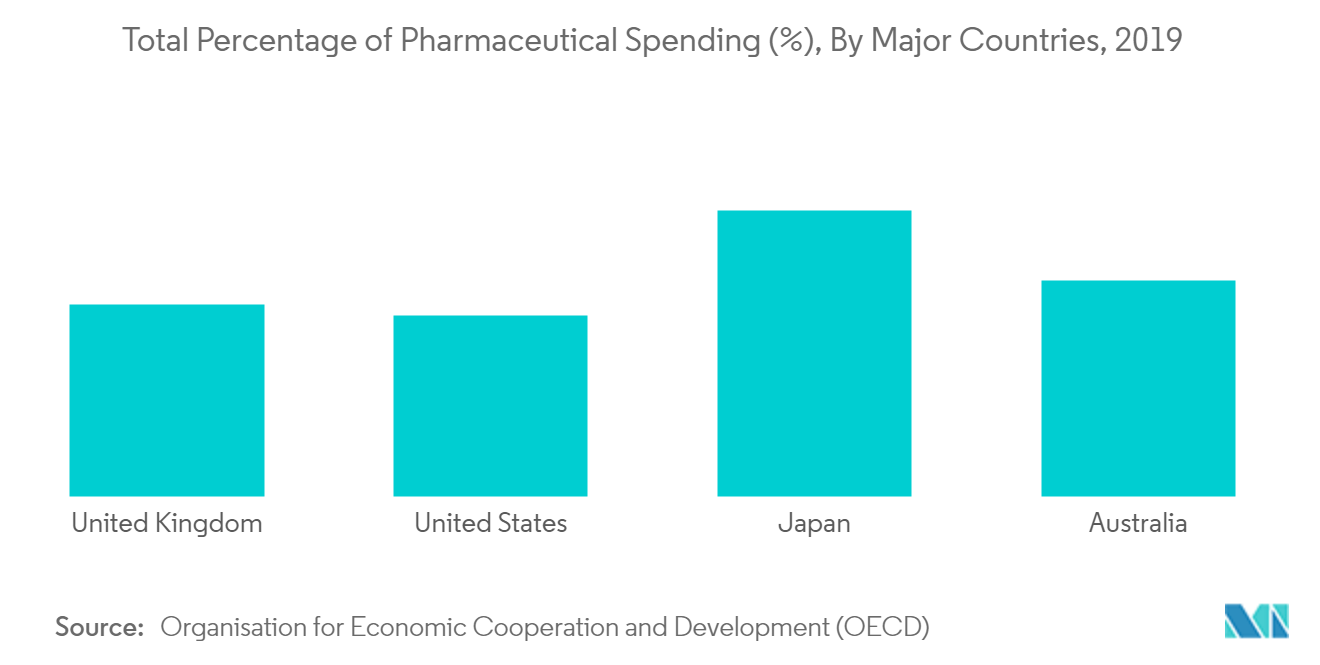
North America is Expected to Witness High Growth Over the Forecast Period
North America is found driving the market due to increased usage of molecular spectroscopy in the pharmaceutical sector, increased funding for environmental testing, rising concerns about food safety, and favorable government initiatives and policies.
Since the COVID-19 outbreak, the production and supply chain of spectroscopic instruments have been restricted due to the lockdowns. Hence, the market is expected to be impacted during the pandemic. According to the article published on the National Institute of Health 2020, spectroscopy is being widely used to detect and monitor COVID-19 cases. However, the local players have experienced an increase in research and development activities related to drug discovery against COVID-19 by various pharmaceutical companies.
For instance, according to the Pharmaceutical Research and Manufacturers Association (PhRMA), the United States is the largest biopharmaceuticals market, accounting for one-third of the global market, and a world leader in biopharmaceutical R&D. The United States also has the world's most supportive domestic environment for the research, development, and commercialization of pharmaceuticals with minimal market barriers. Thus, the use of the spectroscopic technique in drug discovery and development in the United States is expected to rise over the years.
In Canada, there is also the presence of many pharma companies that continue to play a key role in propelling the market growth.
In January 2021, numares AG and Bruker Corporation announced a collaboration agreement to develop novel diagnostics tests utilizing NMR spectroscopy.
In March 2020, trinamiX GmbH, a subsidiary of BASF SE, launched a mobile near-infrared (NIR) spectroscopy solution. Spectroscopy is a well-proven analysis method that trinamiX now makes affordable and accessible beyond factory and laboratory applications. Thus, the increasing R&D activities of pharmaceutical companies in drug discovery and development in the country and new product launches by major players in the United States are expected to drive the molecular spectroscopy market during the forecast period.
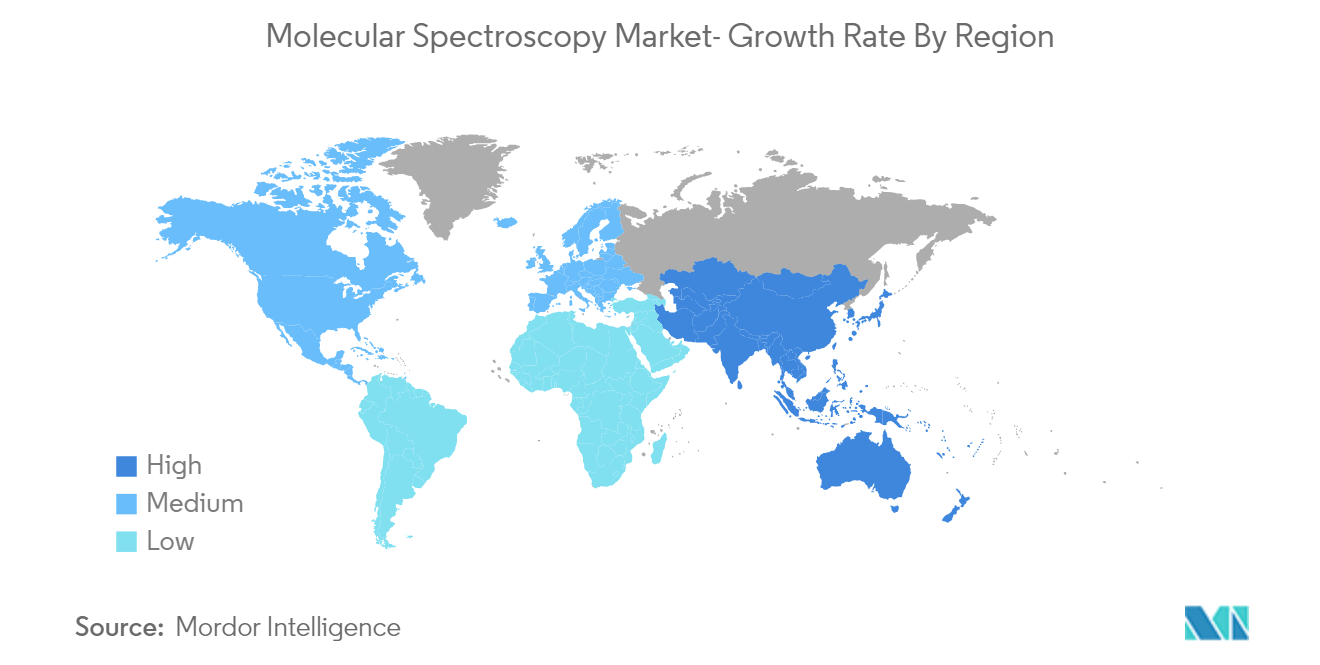
Molecular Spectroscopy Industry Overview
The market for molecular spectroscopy is moderately competitive. With the growing applications of molecular spectroscopy, new players are looking forward to entering the market. In terms of the market share, few companies such as Thermo Fisher Scientific Inc., Agilent, Bruker, and Danaher have better records from the past few years. The players are also involved in activities like mergers, acquisitions, joint ventures, partnerships, and collaborations. These activities help in increasing the influence of the players in the molecular spectroscopy market, eventually driving the market growth.
Molecular Spectroscopy Market Leaders
Danaher Corporation
Agilent Technologies
Bruker Corporation
Horiba Ltd.
Thermo Fisher Scientific
*Disclaimer: Major Players sorted in no particular order
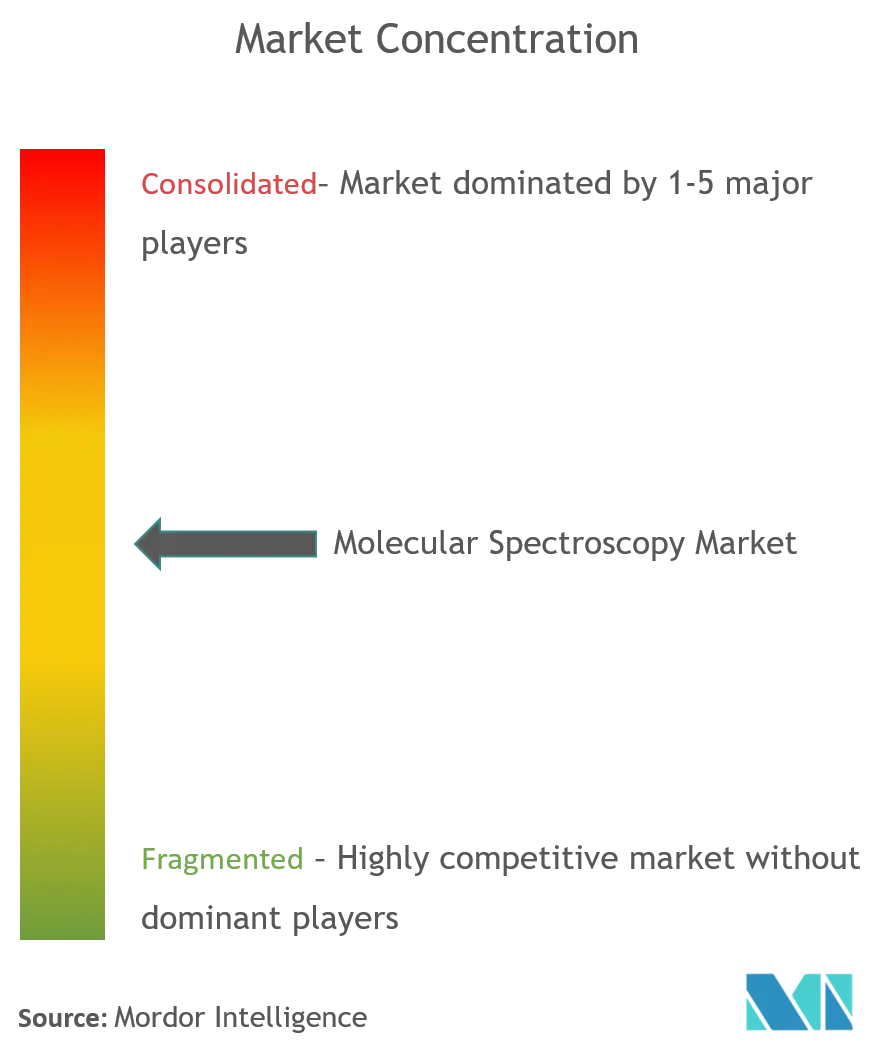
Molecular Spectroscopy Market News
In March 2021, JASCO Corporation launched a new range of fluorescence spectrophotometers (FP-8050 Series) that includes five instruments that cover the entire range of applications for biological, environmental, chemical, and materials analyses.
In October 2020, Bruker Corporation launched the high-performance Fourier 80 system, a next-generation 80 MHz Fourier Transform Nuclear Magnetic Resonance (FT-NMR) benchtop spectrometer, in Europe.
Molecular Spectroscopy Market Report - Table of Contents
1. INTRODUCTION
1.1 Study Deliverables
1.2 Study Assumptions
1.3 Scope of the Study
2. RESEARCH METHODOLOGY (Market Size by Value - USD million)
3. EXECUTIVE SUMMARY
4. MARKET DYNAMICS
4.1 Market Overview
4.2 Market Drivers
4.2.1 Rapid Adoption in the Pharmaceutical Industry
4.2.2 Penetration of MS Technology in Various Verticals
4.2.3 Increased Emphasis for Discovery of Newer Molecules by Pharmaceuticals
4.3 Market Restraints
4.3.1 High Cost of Maintenance and Installation Charges
4.3.2 Need of Technically Skilled Personnel
4.4 Porter's Five Forces Analysis
4.4.1 Threat of New Entrants
4.4.2 Bargaining Power of Buyers/Consumers
4.4.3 Bargaining Power of Suppliers
4.4.4 Threat of Substitute Products
4.4.5 Intensity of Competitive Rivalry
5. MARKET SEGMENTATION (Market Size by Value - USD million)
5.1 Type of Spectroscopy
5.1.1 NMR Spectroscopy
5.1.2 Raman Spectroscopy
5.1.3 UV-visible Spectroscopy
5.1.4 Mass Spectroscopy
5.1.5 Infrared Spectroscopy
5.1.6 Near-infrared Spectroscopy
5.1.7 Other Types of Spectroscopy
5.2 Application
5.2.1 Pharmaceutical Applications
5.2.2 Food and Beverage Testing
5.2.3 Biotechnology and Biopharmaceutical Applications
5.2.4 Environmental Testing
5.2.5 Academic Research
5.2.6 Other Applications
5.3 Geography
5.3.1 North America
5.3.1.1 United States
5.3.1.2 Canada
5.3.1.3 Mexico
5.3.2 Europe
5.3.2.1 Germany
5.3.2.2 United Kingdom
5.3.2.3 France
5.3.2.4 Italy
5.3.2.5 Spain
5.3.2.6 Rest of Europe
5.3.3 Asia-Pacific
5.3.3.1 China
5.3.3.2 Japan
5.3.3.3 India
5.3.3.4 Australia
5.3.3.5 South Korea
5.3.3.6 Rest of Asia-Pacific
5.3.4 Middle-East and Africa
5.3.4.1 GCC
5.3.4.2 South Africa
5.3.4.3 Rest of Middle-East and Africa
5.3.5 South America
5.3.5.1 Brazil
5.3.5.2 Argentina
5.3.5.3 Rest of South America
6. COMPETITIVE LANDSCAPE
6.1 Company Profiles
6.1.1 Agilent Technologies Inc.
6.1.2 Bruker Corporation
6.1.3 Danaher Corporation
6.1.4 Jeol Ltd
6.1.5 Horiba Ltd
6.1.6 Shimadzu Corporation
6.1.7 Thermo Fischer Scientific Inc.
6.1.8 Merck KGaA
6.1.9 PerkinElmer Inc.
6.1.10 VIAVI Solutions Inc.
6.1.11 Thorlabs Inc.
6.1.12 Bio-Rad Laboratories Inc.
6.1.13 Waters Corporation
6.1.14 Keit Ltd
- *List Not Exhaustive
7. MARKET OPPORTUNITIES AND FUTURE TRENDS
Molecular Spectroscopy Industry Segmentation
As per the scope of the report, molecular spectroscopy is the qualitative and quantitative study of molecules by observing their interaction with various frequencies and energy, and in another way, it is the study of the absorption of light by molecules. It is analyzed by ultraviolet (UV) light, visible light, and infrared radiations using an instrument called a spectrometer.
The molecular spectroscopy market is segmented by type of spectroscopy (NMR spectroscopy, Raman spectroscopy, UV-visible spectroscopy, mass spectroscopy, infrared spectroscopy, near-infrared spectroscopy, and other types of spectroscopy), application (pharmaceutical applications, food and beverage testing, biotechnology and biopharmaceutical applications, environmental testing, academic research, and other applications), and geography (North America, Europe, Asia-Pacific, Middle-East and Africa, and South America). The market report also covers the estimated market sizes and trends for 17 different countries across the major regions globally. The report offers the value (in USD million) for all the above segments.
| Type of Spectroscopy | |
| NMR Spectroscopy | |
| Raman Spectroscopy | |
| UV-visible Spectroscopy | |
| Mass Spectroscopy | |
| Infrared Spectroscopy | |
| Near-infrared Spectroscopy | |
| Other Types of Spectroscopy |
| Application | |
| Pharmaceutical Applications | |
| Food and Beverage Testing | |
| Biotechnology and Biopharmaceutical Applications | |
| Environmental Testing | |
| Academic Research | |
| Other Applications |
| Geography | ||||||||
| ||||||||
| ||||||||
| ||||||||
| ||||||||
|
Molecular Spectroscopy Market Research FAQs
How big is the Molecular Spectroscopy Market?
The Molecular Spectroscopy Market size is expected to reach USD 2.87 billion in 2024 and grow at a CAGR of 3.72% to reach USD 3.44 billion by 2029.
What is the current Molecular Spectroscopy Market size?
In 2024, the Molecular Spectroscopy Market size is expected to reach USD 2.87 billion.
Who are the key players in Molecular Spectroscopy Market?
Danaher Corporation, Agilent Technologies, Bruker Corporation, Horiba Ltd. and Thermo Fisher Scientific are the major companies operating in the Molecular Spectroscopy Market.
Which is the fastest growing region in Molecular Spectroscopy Market?
Asia Pacific is estimated to grow at the highest CAGR over the forecast period (2024-2029).
Which region has the biggest share in Molecular Spectroscopy Market?
In 2024, the North America accounts for the largest market share in Molecular Spectroscopy Market.
What years does this Molecular Spectroscopy Market cover, and what was the market size in 2023?
In 2023, the Molecular Spectroscopy Market size was estimated at USD 2.77 billion. The report covers the Molecular Spectroscopy Market historical market size for years: 2019, 2020, 2021, 2022 and 2023. The report also forecasts the Molecular Spectroscopy Market size for years: 2024, 2025, 2026, 2027, 2028 and 2029.
Molecular Spectroscopy Industry Report
Statistics for the 2024 Molecular Spectroscopy market share, size and revenue growth rate, created by Mordor Intelligence™ Industry Reports. Molecular Spectroscopy analysis includes a market forecast outlook to 2029 and historical overview. Get a sample of this industry analysis as a free report PDF download.
